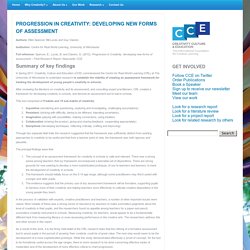

Transforming Creativity and Imagination. Redesign My Brain - Season 1, Episode 2 - Make Me Creative. 9780335244638. ED505548. Creative Learning Assessment - A framework for developing children’s creativity by Giorgio Bertini. Progression in Creativity Final Report April 2012. Progression in Creativity: developing new forms of assessment. Posted on 24 Apr, 2012 Authors: Ellen Spencer, Bill Lucas and Guy Claxton Institution: Centre for Real World Learning, University of Winchester Full reference: Spencer, E., Lucas, B. and Claxton, G. (2012).

Progression in Creativity: developing new forms of assessment – Final Research Report. Newcastle: CCE Summary of key findings In Spring 2011, Creativity, Culture and Education (CCE) commissioned the Centre for Real-World Learning (CRL) at The University of Winchester to undertake research to establish the viability of creating an assessment framework for tracking the development of young people’s creativity in schools. After reviewing the literature on creativity and its assessment, and consulting expert practitioners, CRL created a framework for developing creativity in schools, and derived an assessment tool to trial in schools. This tool comprised of 5 habits and 15 sub-habits of creativity: The principal findings were that: Recommendations for further development include: Read the Report. Educational Leadership:Creativity Now!:Assessing Creativity. K-2 Creativity & Innovation Rubric.
Assessing Creativity in the Classroom: It Needs to Happen! April 22 2014, Volume 1, Issue 3, No. 24 Andrew Miller currently serves on the National Faculty for the Buck Institute for Education and ASCD.

He has given presentations and workshops at many conferences including the National Association for Multicultural Education, ISTE, ASCD, the International Reading Association, the National Council for Teachers of English, and iNACOL’s Virtual Schools Symposium. Andrew is also an avid blogger and writer for a variety of organizations including ASCD, Edutopia and the Huffington Post. Driving Question: How Can We Assess Creativity in the Classroom? Explicitly and effectively assessing creativity is one of my passions. Indeed, we know creativity is not limited to the arts, but that also means we need to provide instructional opportunities for students to be creative in all subject areas, be assessed on creativity, and improve.
Let’s be clear, we are using the word “assess” here. Unpacking Creativity Creativity with Content Consider this example. Questions to foster thinking and creativity. How do students learn critical thinking?

How can creative thinking be taught or learned? How can students be engaged in their own learning? How do some students become better at forming their own questions? TEACHING CREATIVITY We all see that some students are more creative. Many educators assume that creative thinking is an enigma and a gift (or a curse). USING OPEN QUESTIONS One approach is to change my questioning style. DIFFICULTY LEVEL Effective questions are asked when we sense the edge of student thinking ability. MY OWN DISCOVERY One of my most amazing discoveries was when I noticed that my students were actually imitating my questioning methods. WHY DO WE INQUIRE If I use questions merely to confirm that students have been accepting my thinking, I am not motivating autonomous thinking.
As learners, we have instinctive "monkey see monkey do" mirror neurons in our brains. Yes, You Can Teach and Assess Creativity! A recent blog by Grant Wiggins affirmed what I have long believed about creativity: it is a 21st-century skill we can teach and assess. Creativity fosters deeper learning, builds confidence and creates a student ready for college and career. However, many teachers don't know how to implement the teaching and assessment of creativity in their classrooms. While we may have the tools to teach and assess content, creativity is another matter, especially if we want to be intentional about teaching it as a 21st-century skill.
In a PBL project, some teachers focus on just one skill, while others focus on many. Here are some strategies educators can use tomorrow to get started teaching and assessing creativity -- just one more highly necessary skill in that 21st-century toolkit. Quality Indicators If you and your students don't unpack and understand what creativity looks like, then teaching and assessing it will be very difficult.
Activities Targeted to Quality Indicators Model Thinking Skills. 8ways - home. TC.Creative 2.ExperiencesandActivities E1.ObservingCreativity. 30 Things You Can Do To Promote Creativity - InformED. Creativity wheel.